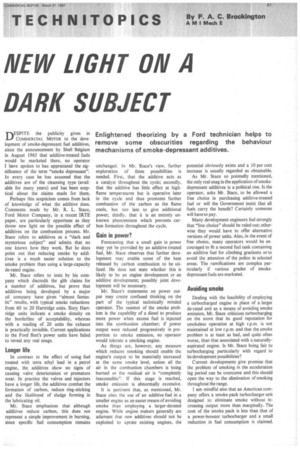NEW LIGHT ON A DARK SUBJECT
Page 49

If you've noticed an error in this article please click here to report it so we can fix it.
Enlightened theorizing by a Ford technician helps to remove some obscurities regarding the behaviour mechanisms of smoke-depressant additives.
DESPITE the publicity given in COMMERCIAL MOTOR to the development of smoke-depressant fuel additives, since the announcement by Shell Belgium in August 1965 that additive-treated fuels would be marketed there, no operator I have spoken to has appreciated the significance of the term "smoke depressant". In every case he has assumed that the additives are of the cleansing type (available for many years) and has been sceptical about the claims made for them.
Perhaps this scepticism comes from lack of knowledge of what the additive does. Comments made by Mr. R. L. Stace, Ford Motor Company, in a recent IRTE paper, are particularly opportune as they throw new light on the possible effect of additives on the combustion process. Mr. Stace refers to additives as a "dark and mysterious subject" and admits that no one knows how they work. But he does point out that reducing smoke by additives is a much easier solution to the smoke problem than using a large-capacity de-rated engine.
Mr. Stace refers to tests by his company which discredit the glib claims for a number of additives, but prove that additives being developed by a major oil company have given "almost fantastic" results, with typical smoke reductions from 60 to 20 Hartridge units. Sixty Hartridge units indicate a smoke density on the borderline of acceptability, whereas with a reading of 20 units the exhaust is practically invisible. Current applications to the Ford fleet's power units have failed to reveal any real snags.
Longer life
In contrast to the effect of using fuel treated with tetra ethyl lead in a petrol engine, the additives show no signs of causing valve deterioration or premature wear. In practice the valves and injectors have a longer life, the additives combat the formation of' carbon, reduce ring-sticking and the likelihood of sludge forming in the lubricating oil.
Mr. Stace emphasizes that although additives reduce carbon, this does not represent a simple improvement in burning, since specific fuel consumption remains unchanged. In Mr. Stace's view, further exploration of three possibilities is needed. First, that the additive acts as a catalyst throughout the cycle; secondly, that the additive has little effect at highflame temperatures but is operative later in the cycle and thus promotes further combustion of the carbon as the flame cools, but too late to give additional power; thirdly, that it is an entirely unknown phenomenon which prevents carbon formation throughout the cycle.
Gain in power?
Forecasting that a small gain in power may yet be provided by an additive treated fuel, Mr. Stace observes that further development may enable some of the heat released by carbon combustion to be utilized. He does not state whether this is likely to be an engine development or an additive development; possibly joint development will be necessary.
Mr. Stace's statements on power output may create confused thinking on the part of the typical technically minded operator. The essence of the smoke problem is the capability of a diesel to produce more power when excess fuel is injected into the combustion chamber; if power output were reduced progressively in proportion to smoke emission, no operator would tolerate a smoking engine.
As things are, however, any measure which reduces smoking should enable the engine's output to be materially increased at the same smoke level, unless all the air in the combustion chambers is being burned or the residual air is "completely inaccessible". If this stage is reached, smoke emission is abnormally excessive.
It is pertinent that, as mentioned, Mr. Stace cites the use of an additive fuel in a smaller engine as an easier means of avoiding smoke than employing a larger-derated engine. While engine makers generally are adamant that new additives should not be exploited to uprate existing engines, the potential obviously exists and a 10 per cent increase is usually regarded as obtainable.
As Mr. Stace so pointedly mentioned, the only real snag in the application of smoke depressant additives is a political one. Is the operator, asks Mr. Stace, to be allowed a free choice in purchasing additive-treated fuel or will the Government insist that all fuels carry the benefit? Certainly someone will have to pay.
Many development engineers feel strongly that "free choice" should be ruled out; otherwise they would have to offer alternative versions of power units. Also, in the event of free choice, many operators would be encouraged to fit a second fuel tank containing an additive fuel for climbing gradients or to avoid the attention of the police in selected areas. The ramifications are complex particularly if various grades of smoke depressant fuels are marketed.
Avoiding smoke
Dealing with the feasibility of employing a turbocharged engine in place of a larger de-rated unit as a means of avoiding smoke emission, Mr. Stace criticizes turbocharging on the score that its good reputation for smokeless operation at high r.p.m. is not maintained at low r.p.m. and that the smoke problem is at least as bad, and quite often worse, than that associated with a naturallyaspirated engine. Is Mr. Stace being fair to turbocharging particularly with regard to its development possibilities?
Current developments give promise that the problem of smoking in the acceleration lag period can be overcome and this should open the way to the elimination of smoking throughout the range.
I am mindful also that an American company offers a smoke-pack turbocharger unit designed to eliminate smoke without increasing output more than marginally. The cost of the smoke pack is less than that of a power-booster turbocharger and a small reduction in fuel consumption is claimed.
















































































































